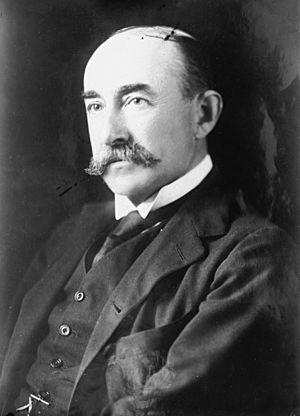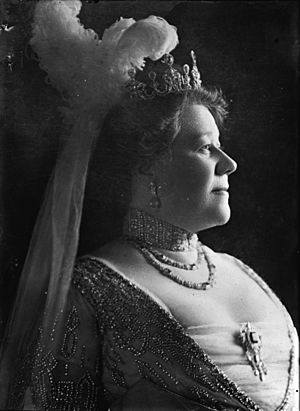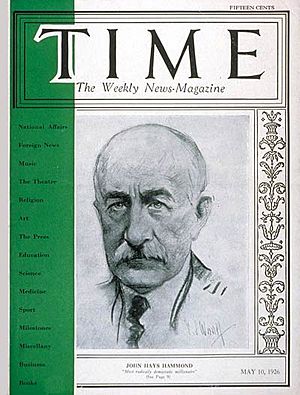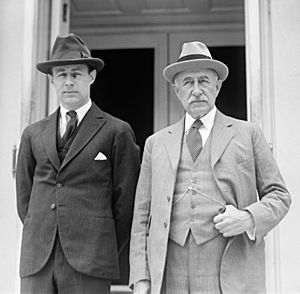John Hays Hammond facts for kids
Quick facts for kids
John Hays Hammond
|
|
|---|---|
 |
|
| Born | March 31, 1855 San Francisco, California, US
|
| Died | June 8, 1936 (aged 81) Gloucester, Massachusetts, US
|
| Resting place | Green-Wood Cemetery, Brooklyn, New York, US |
| Alma mater | Yale University (Ph.B., 1876) |
| Occupation | mining engineer, diplomat |
| Spouse(s) | Natalie Harris (January 1, 1881–June 18, 1931) |
| Children | John Hays Hammond, Jr. (April 13, 1888–February 12, 1965) Natalie Hays Hammond (1904–1985) Nathaniel Harris Hammond (?–1906) Richard Pindle Hammond Harris Hays Hammond (November 27, 1881–August 9,1969) |
| Parent(s) | Sarah (Hays) Lea Richard Pindell Hammond |
John Hays Hammond (born March 31, 1855 – died June 8, 1936) was a famous American mining engineer. He was also a diplomat and a generous person who gave a lot to charity. He became very rich before he was 40 years old.
Hammond was a big supporter of deep mining. This means digging very deep into the ground to find valuable minerals. He was put in charge of Cecil Rhodes' mines in South Africa. He made all these mining projects very successful.
He was involved in planning the Jameson Raid in 1895. This event did not go well. Hammond and other leaders were arrested. They were later released after paying large fines. After this, Hammond left Africa for good. He returned to the United States. He became a close friend of President William Howard Taft. Taft appointed him as a special ambassador.
Hammond kept working on mines in Mexico and California. In 1923, he made another fortune. This happened while drilling for oil with the Burnham Exploration Company.
Contents
Early Life and Education
John Hays Hammond was the son of Major Richard Pindell Hammond. His father was a West Point graduate. He fought in the Mexican War. John's mother was Sarah. Her brother was Captain John Coffee Hays of the Texas Rangers.
In 1849, his family moved to California. They wanted to find gold during the California gold rush. John was born in San Francisco. He had an exciting childhood in the American Old West. Later, he went East for school. He attended the Sheffield Scientific School at Yale University. He earned a degree there in 1876. He also studied at the Royal School of Mines in Germany. There, he met his future wife, Natalie Harris.
Mining Career and Success
Hammond's first mining job was for the US Geological Survey. He worked as a special expert from 1879 to 1880. In 1881, he went back to California. He worked for Senator George Hearst, a powerful mining owner.
In 1882, he was sent to Mexico. He became the superintendent of Minas Nuevas. When a revolution started, Hammond protected his family. He barricaded them in a small house. He fought off the attacking groups.
From 1884 to 1893, Hammond worked in San Francisco. He was a consulting engineer for several large companies. In 1893, he went to South Africa. He investigated gold mines in Transvaal. In 1894, he joined the British South Africa Company. He worked with Cecil Rhodes and opened mines. These mines were in the Rand and Mashonaland.
By 1895, he was managing Rhodes' properties in Transvaal. His main office was in Johannesburg, South Africa. Hammond believed in deep-level mining. He was given full control of Rhodes' gold and diamond mines. He made every project a financial success. His work for Rhodes made him famous worldwide as an engineer. He worked for Rhodes until 1899.
The Reform Committee in Transvaal
When Hammond arrived in Transvaal, the political situation was difficult. Many foreign workers came because of the gold rush. Most were British and American. The local people, called Boers, called them "Uitlanders" (foreigners).
These immigrants formed a Reform Committee. It was led by Colonel Frank Rhodes (Cecil's brother), Hammond, and others. They asked for fair laws and a better education system. They felt the government under President Paul Kruger was not keeping its promises.
Things became worse when Leander Starr Jameson invaded Transvaal. He was captured by the Boers in December 1895. Soon after, the Boer government arrested Hammond. Many other Reform Committee members were also arrested. They were held in tough conditions. The U.S. Senate asked President Kruger to be kind to them.
The Reform Committee's case was heard in April. Hammond and others were sentenced to be hanged. But President Kruger changed their sentence the next day. For a few weeks, they stayed in jail. In May, they were told they would spend 15 years in prison. But by mid-June, Kruger changed their sentences again. Hammond and others paid a fine of £2,000 each. The main leaders paid £25,000 each. All the fines were paid by Rhodes. Soon after, Hammond left for England.
Return to the United States

Around 1900, Hammond, now famous, moved back to the U.S. He worked on mining properties in the U.S. and Mexico. He became a professor of mining engineering at Yale University from 1902 to 1909. From 1903 to 1907, he worked for Daniel Guggenheim. He was a highly paid manager and engineer for the Guggenheim Exploration Company.
Hammond's five-year contract included a large salary. He also got a share from each property he brought to the company. He earned $1.2 million in his first year alone.
Involvement in Politics
In 1907, Hammond became the first president of the Rocky Mountain Club. He stayed president until the club closed in 1928. Hammond was also active in the Republican Party. He became a close friend of President William Howard Taft. They had known each other since their Yale student days.
In early 1908, it was announced that Hammond might run for Vice-President. But he did not get many votes at the national meeting. Still, he met many important politicians. He became the president of the League of Republican Clubs. He moved to Washington, D.C., to be closer to President Taft. He often traveled with the President.
In 1911, Taft sent him to the coronation of King George V. He went as a special U.S. Ambassador. Taft also sent him twice to help Nicholas II of Russia with engineering problems. Besides Taft, Hammond was also friends with Presidents Grant, Hayes, Roosevelt, and Coolidge.
Hammond became chairman of the U.S. Coal Commission from 1922 to 1923. His friendship with Frederick Russell Burnham helped him. Burnham was a famous Scout whom Hammond knew from Africa. This friendship led Hammond to become a rich oil man. The Burnham Exploration Company found oil in California in 1923.
A Special Celebration in 1926
In May 1926, a group called "The Company of Friends of John Hays Hammond" honored him. They held eleven dinners around the world. These dinners were in places like Manhattan, San Francisco, London, Paris, and Tokyo.
Over 10,000 people wrote tributes to Hammond. These included people like Hearst, whose father gave him his first job. Also, Woolf Barnato, whose father took him to South Africa. Sir Lionel Phillips, who was arrested with him, also wrote a tribute. The Guggenheims, who paid him a lot, and former President Taft also sent messages. President Calvin Coolidge, who asked Hammond for advice on coal, also honored him. This event was so special that Time magazine featured Hammond on its cover. This was on May 10, 1926. They also wrote a story about him called "Unique."
John Hays Hammond died on June 8, 1936. He was 81 years old. He died in his home in Gloucester, Massachusetts.
Family Life
He married Natalie Harris (1859 – 1931) on January 1, 1881. She was from Mississippi. They had four sons and one daughter together:
- Harris Hays Hammond (1881 - 1969) became a financier. He was president of Dominguez Oil Fields Company. He also led Laughlin Filter Corporation.
- John Hays Hammond, Jr. (1888 - 1965) was born in San Francisco. He moved to South Africa and then England with his family. In 1900, they returned to the U.S. He studied at Yale University. He started the Hammond Radio Research Corporation in 1911. He developed a radio-controlled torpedo system for the navy. He built a medieval-style castle in Gloucester, Massachusetts, between 1926 and 1929.
- Natalie Hays Hammond (1904 – 1985) was born in New Jersey. Her property in North Salem, New York became the Hammond Museum & Japanese Stroll Garden in 1957.
- Nathaniel Harris Hammond (1902 - 1907) and Richard Pindle Hammond (1896 – 1980), a composer, were their other two children.
John Hays Hammond passed away in 1936. He left behind a large amount of money. Most of it went to his four surviving children.
Awards and Recognition
The Franklin Institute gave John Hays Hammond Jr. the Elliott Cresson Medal in 1959. This award was for his lifetime achievements. He is often called the ‘Father of Radio Control’.
See also
- List of people on the cover of Time Magazine: 1920s - 10 May 1926




